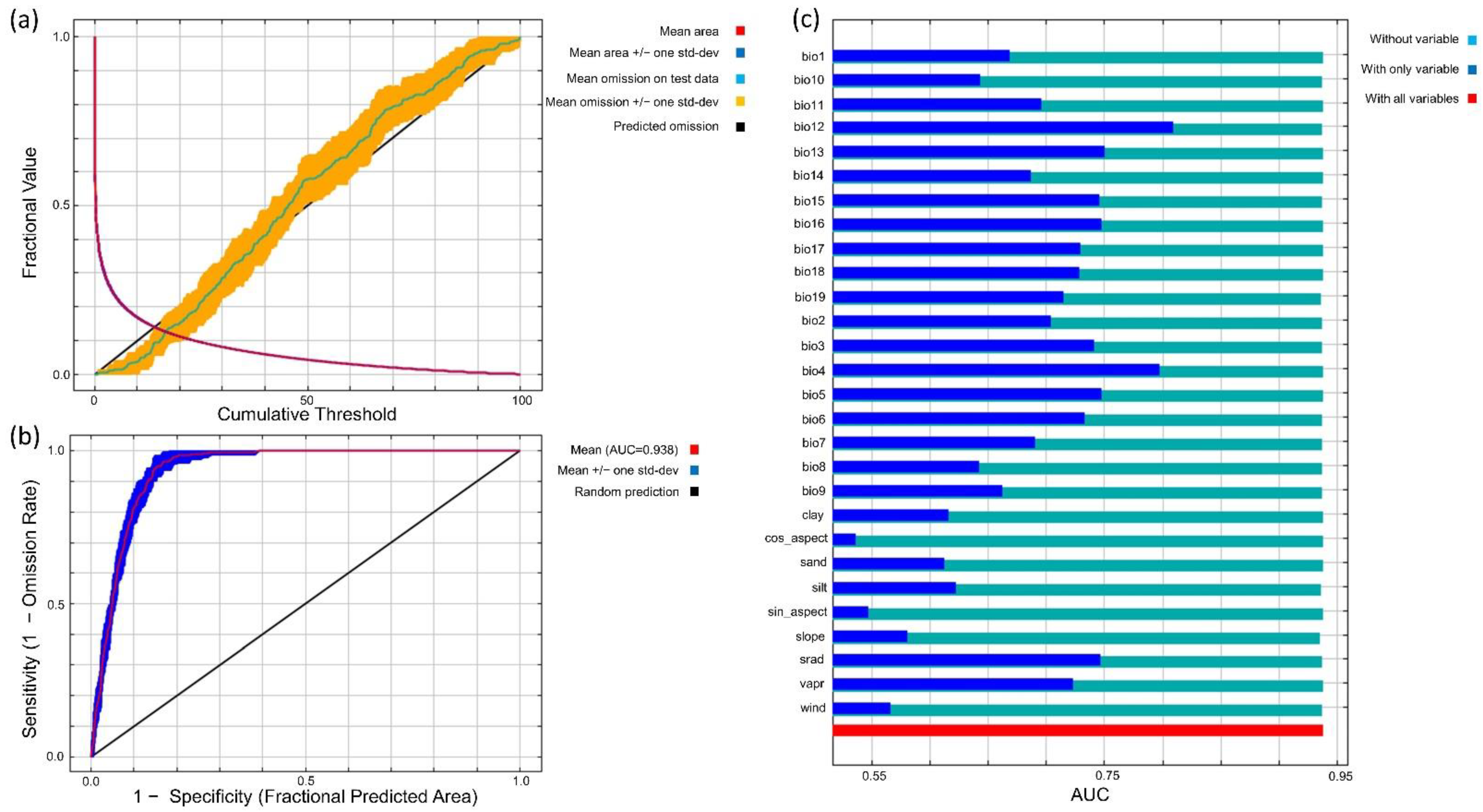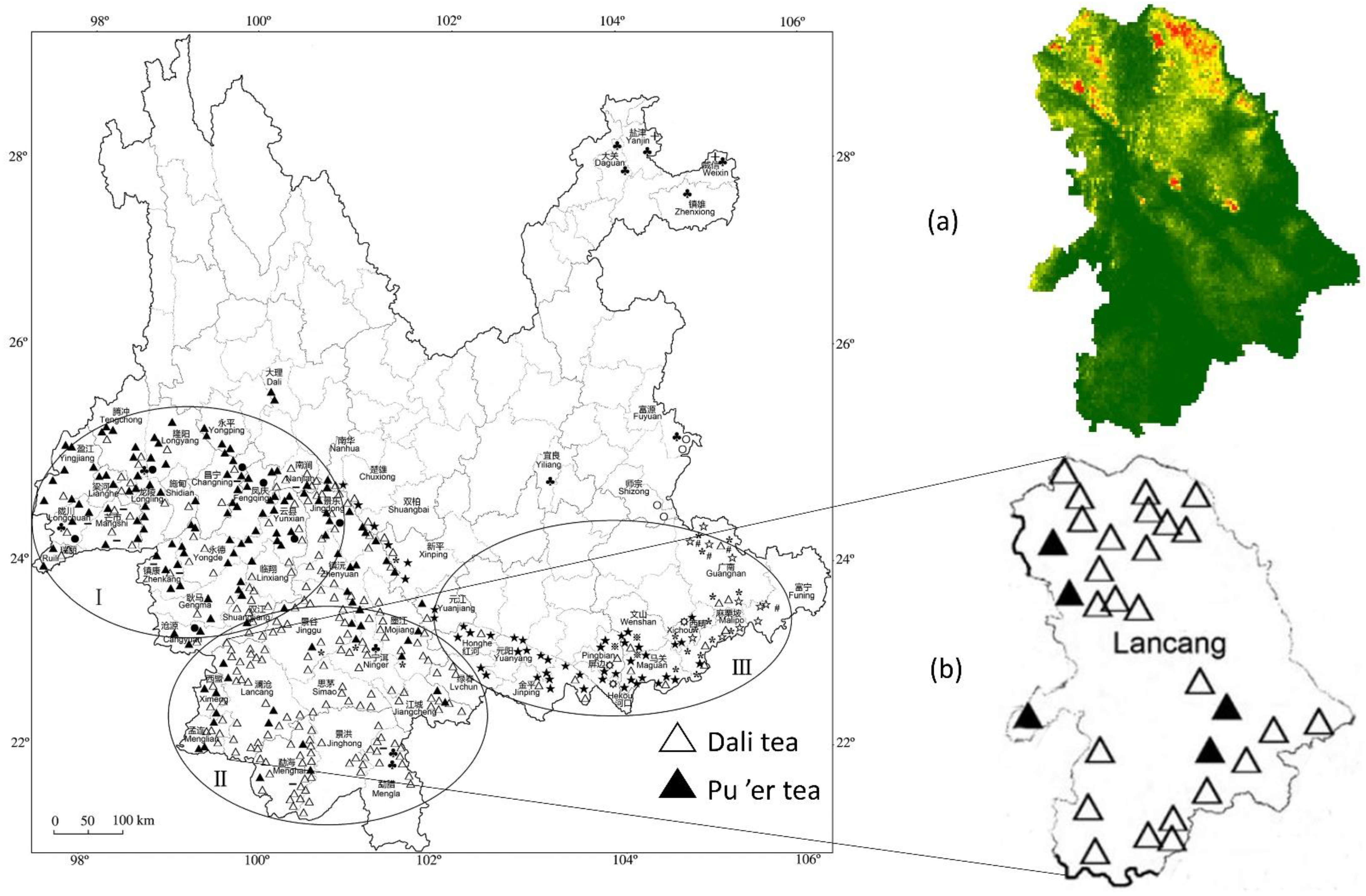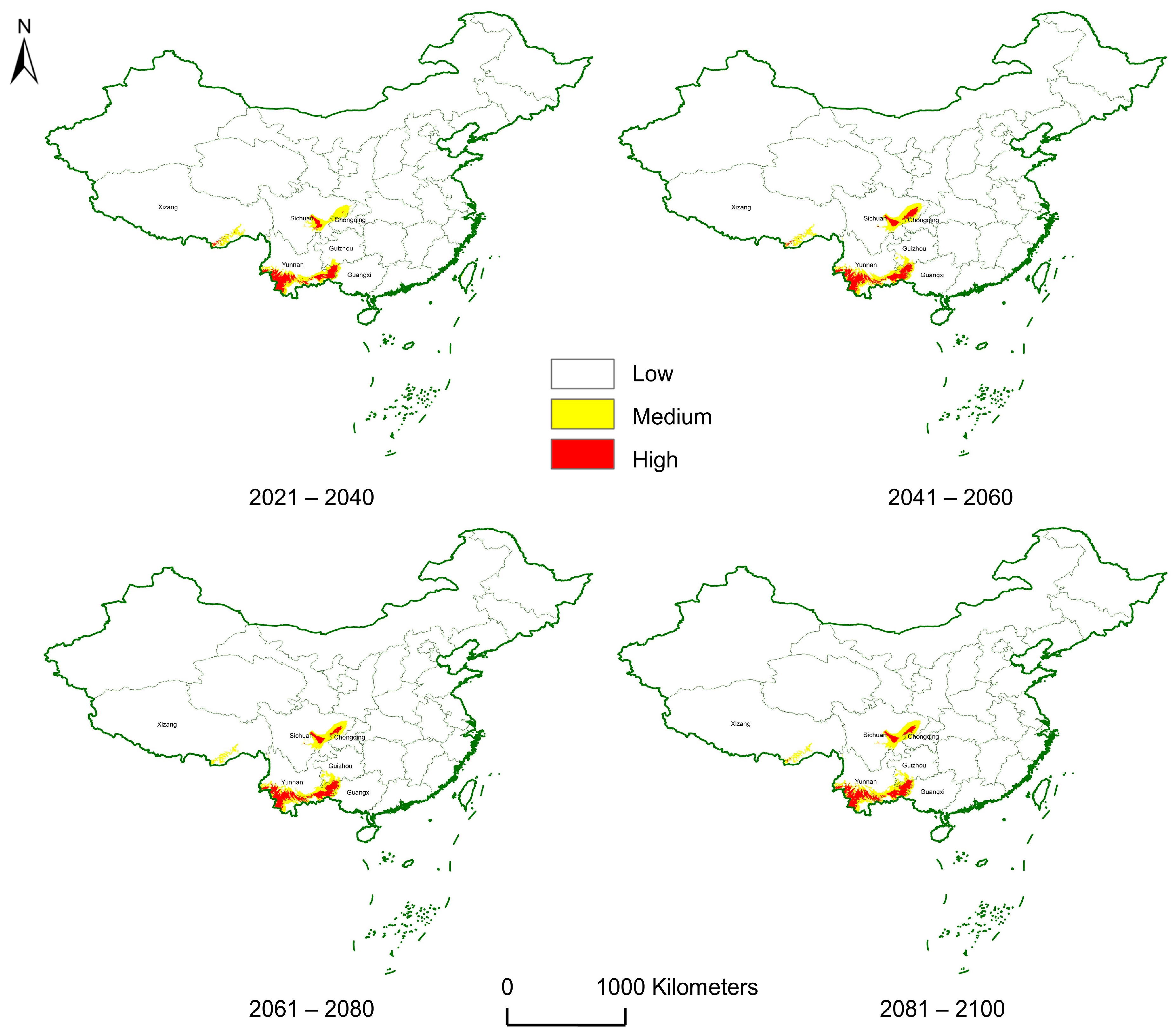The Future Potential Distribution and Sustainable Management of Ancient Pu’er Tea Trees (Camellia sinensis var. assamica (J. W. Mast.) Kitam.)
Abstract
:1. Introduction
2. Materials and Methods
2.1. Study Area
2.2. Data
2.3. Calibration and Validation
3. Results
3.1. Niches and Distributions
3.2. Management
- (1)
- Disturbances from humans and livestock.
- (2)
- Weak protection awareness.
- (3)
- Lack of management techniques.
- (1)
- Habitat management.
- (2)
- Tree growth management.
- (3)
- Harvest management.
4. Discussion
- (1)
- Improve and unify management regulations.
- (2)
- Increase publicity and education.
- (3)
- Increase investments in technologies and the livelihoods of natives.
- (4)
- Quality control for brand building.
- (5)
- Collect and preserve germplasm resources for long-term use.
5. Conclusions
Author Contributions
Funding
Institutional Review Board Statement
Informed Consent Statement
Data Availability Statement
Acknowledgments
Conflicts of Interest
References
- Brody, H. Tea. Nature 2019, 566, S1. [Google Scholar] [CrossRef] [PubMed] [Green Version]
- Nowogrodzki, A. How climate change might affect tea. Nature 2019, 566, S10–S11. [Google Scholar] [CrossRef] [PubMed] [Green Version]
- Kfoury, N.; Scott, E.R.; Orians, C.M.; Ahmed, S.; Cash, S.B.; Griffin, T.; Matyas, C.; Stepp, J.R.; Han, W.; Xue, D.; et al. Plant-Climate Interaction Effects: Changes in the Relative Distribution and Concentration of the Volatile Tea Leaf Metabolome in 2014–2016. Front. Plant Sci. 2019, 10, 1518. [Google Scholar] [CrossRef] [PubMed] [Green Version]
- Meegahakumbura, M.K.; Wambulwa, M.C.; Li, M.-M.; Thapa, K.K.; Sun, Y.-S.; Möller, M.; Xu, J.-C.; Yang, J.-B.; Liu, J.; Liu, B.-Y.; et al. Domestication Origin and Breeding History of the Tea Plant (Camellia sinensis) in China and India Based on Nuclear Microsatellites and cpDNA Sequence Data. Front. Plant Sci. 2017, 8, 2270. [Google Scholar] [CrossRef] [Green Version]
- Banerjee, B. Botanical Classification of Tea; Springer: Dordrecht, Germany, 1992. [Google Scholar]
- Wight, W. A Revision of the Genus Camellia. Theor. Appl. Genet. 1959, 28, 89. [Google Scholar]
- Zhang, H. Systematic Classification of Tea Plants. J. Sun Yatsen Univ. 1981, 89–101. [Google Scholar]
- Li, M.; Meegahakumbura, M.K.; Yan, L.; Liu, J.; Gao, L. Genetic Involvement of Camellia taliensis in the Domestication of C. sinensis var. assamica (Assimica Tea) Revealed by Nuclear Microsatellite Markers. Plant Divers. Resour. 2015, 37, 29–37. [Google Scholar]
- Zhang, J. Puer Tea: Ancient Caravans and Urban Chic; University of Washington Press: Seattle, WA, USA, 2014. [Google Scholar]
- Lu, L.; Chen, H.; Wang, X.; Zhao, Y.; Yao, X.; Xiong, B.; Deng, Y.; Zhao, D. Genome-level diversification of eight ancient tea populations in the Guizhou and Yunnan regions identifies candidate genes for core agronomic traits. Hortic. Res. 2021, 8, 190. [Google Scholar] [CrossRef]
- Zhao, Y.; Wang, R.; Liu, Q.; Dong, X.; Zhao, D.-G. Genetic Diversity of Ancient Camellia sinensis (L.) O. Kuntze in Sandu County of Guizhou Province in China. Diversity 2021, 13, 276. [Google Scholar] [CrossRef]
- Bonte, F.; Ulrichova, J.; Saladin, R. Skin Antiaging and Detoxifying Properties of Ancient Tea Forest Pu’er Tea. Free. Radic. Biol. Med. 2016, 100, S80. [Google Scholar] [CrossRef]
- Fischer, J.; Zerger, A.; Gibbons, P.; Stott, J.; Law, B.S. Tree decline and the future of Australian farmland biodiversity. Proc. Natl. Acad. Sci. USA 2010, 107, 19597–19602. [Google Scholar] [CrossRef] [PubMed] [Green Version]
- Le Roux, D.S.; Ikin, K.; Lindenmayer, D.B.; Manning, A.D.; Gibbons, P. The future of large old trees in urban landscapes. PLoS ONE 2014, 9, e99403. [Google Scholar] [CrossRef] [PubMed]
- Linder, P.; Östlund, L. Structural changes in three mid-boreal Swedish forest landscapes, 1885–1996. Biol. Conserv. 1998, 85, 9–19. [Google Scholar] [CrossRef]
- Laurance, W.F.; Delamônica, P.; Laurance, S.G.; Vasconcelos, H.L.; Lovejoy, T.E. Rainforest fragmentation kills big trees. Nature 2000, 404, 836. [Google Scholar] [CrossRef]
- Gibbons, P.; Lindenmayer, D.B.; Fischer, J.; Manning, A.D.; Weinberg, A.; Seddon, J.; Ryan, P.; Barrett, G. The future of scattered trees in agricultural landscapes. Conserv. Biol. 2008, 22, 1309–1319. [Google Scholar] [CrossRef]
- Benn, J.A. Tea in China: A Religious and Cultural History; University of Hawaii Press: Honolulu, HI, USA, 2015. [Google Scholar]
- Rose, S. For All the Tea in China: How England Stole the World’s Favorite Drink and Changed History; Penguin Books: New York, NY, USA, 2011. [Google Scholar]
- Dutta, R. Climate change and its impact on tea in Northeast India. J. Water Clim. Chang. 2014, 5, 625–632. [Google Scholar] [CrossRef]
- Wamalwa, B.P. Sustainable Supply Chain Management as a Strategic Tool for Competitive Advantage in Tea Industry in Kenya. J. Manag. Sustain. 2014, 4, 157. [Google Scholar] [CrossRef]
- Campbell, E.M.; Magnussen, S.; Antos, J.A.; Parish, R. Size-, species-, and site-specific tree growth responses to climate variability in old-growth subalpine forests. Ecosphere 2021, 12, e03529. [Google Scholar] [CrossRef]
- Larjavaara, M. The world’s tallest trees grow in thermally similar climates. New Phytol. 2014, 202, 344–349. [Google Scholar] [CrossRef]
- Slik, J.W.F.; Paoli, G.; McGuire, K.; Amaral, I.; Barroso, J.; Bastian, M.; Blanc, L.; Bongers, F.; Boundja, P.; Clark, C.; et al. Large trees drive forest aboveground biomass variation in moist lowland forests across the tropics. Glob. Ecol. Biogeogr. 2013, 22, 1261–1271. [Google Scholar] [CrossRef]
- Kim, D.; Arthur, M.A. Changes in community structure and species–landform relationship after repeated fire disturbance in an oak-dominated temperate forest. Ecol. Res. 2014, 29, 661–671. [Google Scholar] [CrossRef]
- You, Q.; Kociolek, J.P.; Yu, P.; Cai, M.; Lowe, R.; Wang, Q. A new species ofSimonseniafrom a karst landform, Maolan Nature Reserve, Guizhou Province, China. Diatom Res. 2016, 31, 269–275. [Google Scholar] [CrossRef]
- Venter, M.; Dwyer, J.; Dieleman, W.; Ramachandra, A.; Gillieson, D.; Laurance, S.; Cernusak, L.A.; Beehler, B.; Jensen, R.; Bird, M.I. Optimal climate for large trees at high elevations drives patterns of biomass in remote forests of Papua New Guinea. Glob. Chang. Biol. 2017, 23, 4873–4883. [Google Scholar] [CrossRef] [PubMed]
- Lindenmayer, D.B.; Laurance, W.F. The ecology, distribution, conservation and management of large old trees. Biol. Rev. Camb. Philos. Soc. 2017, 92, 1434–1458. [Google Scholar] [CrossRef] [PubMed]
- Pavlin, J.; Nagel, T.A.; Svitok, M.; Pettit, J.L.; Begović, K.; Mikac, S.; Dikku, A.; Toromani, E.; Panayotov, M.; Zlatanov, T.; et al. Disturbance history is a key driver of tree life span in temperate primary forests. J. Veg. Sci. 2021, 32, e13069. [Google Scholar] [CrossRef]
- Soley-Guardia, M.; Radosavljevic, A.; Rivera, J.L.; Anderson, R.P. The effect of spatially marginal localities in modelling species niches and distributions. J. Biogeogr. 2014, 41, 1390–1401. [Google Scholar] [CrossRef]
- Koch, A.; Kaplan, J.O. Tropical forest restoration under future climate change. Nat. Clim. Chang. 2022, 12, 279–283. [Google Scholar] [CrossRef]
- Janusz, C.; Radosław, G.; Kamil, M.; Magdalena, J.; Jan, T.; Łukasz, S. The influence of the forest management in the Białowieża forest on the species structure of the forest community. For. Ecol. Manag. 2021, 496, 119363. [Google Scholar] [CrossRef]
- Shen, Q.; Zhang, X.; Li, L.; He, Y. Analysis of Sensory Quality and Chemical Components for Ancient Tea Trees in Yanhe. Guizhou Nong Ye Ke Xue 2015, 43. [Google Scholar]
- Sigley, G. Reimagining the ‘Central Plains’ (Zhongyuan) and ‘Borderlands’ (Bianjiang): The cultural heritage scholarship of the Ancient Tea Horse Road (Chamagudao) of Southwest China. Int. J. Herit. Stud. IJHS 2021, 27, 904–919. [Google Scholar] [CrossRef]
- Ji, P.-Z.; Jiang, H.-B.; Huang, X.-Q.; Zhang, J.; Liang, M.-Z.; Wang, P.-S. Genetic diversity of ancient tea gardens and tableland tea gardens from Yunnan Province as revealed by AFLP marker. Yíchuán 2009, 31, 101–108. [Google Scholar] [CrossRef] [PubMed]
- Tian, G.; Xu, Y.; Gao, Y.; Wang, Y. Ecological Environment of Erhai and Lashihai Watersheds of the Ancient Tea Horse Road on the Yunnan-Tibet Line. J. Coast. Res. 2020, 115, 401–404. [Google Scholar] [CrossRef]
- Gamage, D.; Thompson, M.; Sutherland, M.; Hirotsu, N.; Makino, A.; Seneweera, S. New insights into the cellular mechanisms of plant growth at elevated atmospheric carbon dioxide concentrations. Plant Cell Environ. 2018, 41, 1233–1246. [Google Scholar] [CrossRef] [PubMed]
- Hayes, S. Why Do Leaves Rise with the Temperature? Plant Physiol. 2019, 180, 691–692. [Google Scholar] [CrossRef] [Green Version]
- Mirza, H. Plant Ecophysiology and Adaptation under Climate Change: Mechanisms and Perspectives I: General Consequences and Plant Responses; Springer: Singapore, 2020. [Google Scholar]
- Pu’er-Municipal-People’s-Government. Geographical Environment (Translated). Available online: www.puershi.gov.cn (accessed on 4 March 2022).
- Fick, S.E.; Hijmans, R.J. WorldClim 2: New 1-km spatial resolution climate surfaces for global land areas. Int. J. Climatol. 2017, 37, 4302–4315. [Google Scholar] [CrossRef]
- NASA. Advanced Land Observing Satellite-1. Available online: https://search.asf.alaska.edu (accessed on 11 February 2022).
- Resource and Environment Science and Data Center. Soil Texture Spatial Distribution Data in China. Available online: www.resdc.cn (accessed on 17 January 2022).
- Yukimoto, S.; Kawai, H.; Koshiro, T.; Oshima, N.; Yoshida, K.; Urakawa, S.; Tsujino, H.; Deushi, M.; Tanaka, T.; Hosaka, M.; et al. The Meteorological Research Institute Earth System Model Version 2.0, MRI-ESM2.0: Description and Basic Evaluation of the Physical Component. J. Meteorol. Soc. Jpn. Ser. II 2019, 97, 931–965. [Google Scholar] [CrossRef] [Green Version]
- Eyring, V.; Bony, S.; Meehl, G.A.; Senior, C.A.; Stevens, B.; Stouffer, R.J.; Taylor, K.E. Overview of the Coupled Model Intercomparison Project Phase 6 (CMIP6) experimental design and organization. Geosci. Model Dev. 2016, 9, 1937–1958. [Google Scholar] [CrossRef] [Green Version]
- Liao, S.; Li, L.; Lv, H.; Wu, W.; Wang, Z.; Kong, W.; Li, Z.; Ma, F.; Xu, L. Jinggu Dai and Yi Autonomous County Ancient (Wild) Tea Trees Resources; Yunnan Institute of Forest Inventory and Planning, Chinese Academy of Forestry Research Institute of Resource Insects: Pu’er, Yunnan, China, 2019. [Google Scholar]
- Phillips, S.J.; Anderson, R.P.; Dudík, M.; Schapire, R.E.; Blair, M.E. Opening the black box: An open-source release of Maxent. Ecography 2017, 40, 887–893. [Google Scholar] [CrossRef]
- Bradie, J.; Leung, B. A quantitative synthesis of the importance of variables used in MaxEnt species distribution models. J. Biogeogr. 2017, 44, 1344–1361. [Google Scholar] [CrossRef]
- Sobek-Swant, S.; Kluza, D.A.; Cuddington, K.; Lyons, D.B. Potential distribution of emerald ash borer: What can we learn from ecological niche models using Maxent and GARP? For. Ecol. Manag. 2012, 281, 23–31. [Google Scholar] [CrossRef]
- Phillips, S.J.; Anderson, R.P.; Schapire, R.E. Maximum entropy modeling of species geographic distributions. Ecol. Model. 2006, 190, 231–259. [Google Scholar] [CrossRef] [Green Version]
- Khan, A.M.; Li, Q.; Saqib, Z.; Khan, N.; Habib, T.; Khalid, N.; Majeed, M.; Tariq, A. MaxEnt Modelling and Impact of Climate Change on Habitat Suitability Variations of Economically Important Chilgoza Pine (Pinus gerardiana Wall.) in South Asia. Forests 2022, 13, 715. [Google Scholar] [CrossRef]
- Li, Y.; Li, M.; Li, C.; Liu, Z. Optimized Maxent Model Predictions of Climate Change Impacts on the Suitable Distribution of Cunninghamia lanceolata in China. Forests 2020, 11, 302. [Google Scholar] [CrossRef] [Green Version]
- Elith, J.; Phillips, S.J.; Hastie, T.; Dudík, M.; Chee, Y.E.; Yates, C.J. A statistical explanation of MaxEnt for ecologists. Divers. Distrib. 2011, 17, 43–57. [Google Scholar] [CrossRef]
- Jiang, H.; Tang, Y.; Chen, L.; Wang, P.; Cai, X.; Yu, F.; Yang, L.; Wang, X.; Li, C.; Jiang, H.; et al. Survey and Analysis of Ancient Tea Plant Resources in Yunnan Province, China. J. Plant Genet. Resour. 2020, 21, 296–307. [Google Scholar]
- Zhang, Z.; Sun, J.; Liu, M.; Shang, H.; Wang, J.; Wang, J.; Zhou, H.; Li, Y.; Wang, Y.; Chen, W. Context-Dependency in Relationships Between Herbaceous Plant Leaf Traits and Abiotic Factors. Front. Plant Sci. 2022, 13, 757077. [Google Scholar] [CrossRef]
- Ahmad, A.; Ahmad, S.R.; Gilani, H.; Tariq, A.; Zhao, N.; Aslam, R.W.; Mumtaz, F. A Synthesis of Spatial Forest Assessment Studies Using Remote Sensing Data and Techniques in Pakistan. Forests 2021, 12, 1211. [Google Scholar] [CrossRef]
- Yackulic, C.B.; Chandler, R.; Zipkin, E.F.; Royle, J.A.; Nichols, J.D.; Campbell Grant, E.H.; Veran, S.; O’Hara, R.B. Presence-only modelling using MAXENT: When can we trust the inferences? Methods Ecol. Evol. 2013, 4, 236–243. [Google Scholar] [CrossRef]
- Jiang, R.; Zou, M.; Qin, Y.; Tan, G.; Huang, S.; Quan, H.; Zhou, J.; Liao, H. Modeling of the Potential Geographical Distribution of Three Fritillaria Species Under Climate Change. Front. Plant Sci. 2022, 12, 749838. [Google Scholar] [CrossRef]







| Parameter | Full Name or Description (*) | Range | Suitable Range | Contribution | Importance |
|---|---|---|---|---|---|
| bio1 | Annual Mean Temperature (°C) | 10.29–23.05 | 16–18.4 | 0.1726 | 0.3341 |
| bio2 | Mean Diurnal Range (Mean of Monthly (Max Temp–Min Temp)) (°C) | 9.25–12.95 | 10.75–11.4 | 0.4695 | 1.2062 |
| bio3 | Isothermality (BIO2/BIO7) (×100) (%) | 47.02–53.25 | 49.7–50.6 | 14.1137 | 6.043 |
| bio4 | Temperature Seasonality (Standard Deviation × 100) | 307.35–448.04 | 382–400 | 4.4546 | 5.9208 |
| bio5 | Max Temperature of Warmest Month (°C) | 16.4–36.3 | 24.6–27.4 | 0.0122 | 0.0059 |
| bio6 | Min Temperature of Coldest Month (°C) | −2.2–11.3 | 3.2–5.1 | 18.2508 | 21.1368 |
| bio7 | Temperature Annual Range (BIO5-BIO6) (°C) | 18.6–25 | 21.4–22.3 | 0.3642 | 1.7058 |
| bio8 | Mean Temperature of Wettest Quarter (°C) | 14.55–26.45 | 20.2–22.5 | 0.0606 | 0.0045 |
| bio9 | Mean Temperature of Driest Quarter (°C) | 4.87–19.35 | 12.7–14.9 | 0.372 | 1.1455 |
| bio10 | Mean Temperature of Warmest Quarter (°C) | 14.55–26.45 | 20.2–22.5 | 0.0688 | 0.012 |
| bio11 | Mean Temperature of Coldest Quarter (°C) | 4.87–17.73 | 10.8–13.1 | 0.339 | 0.923 |
| bio12 | Annual Precipitation (mm) | 916–1616 | 1180–1320 | 29.7282 | 26.749 |
| bio13 | Precipitation of Wettest Month (mm) | 173–342 | 238–277 | 0.1212 | 0.0362 |
| bio14 | Precipitation of Driest Month (mm) | 5–22 | 13.2–15.8 | 0.037 | 0.4047 |
| bio15 | Precipitation Seasonality (Coefficient of Variation) | 74.48–90.55 | 87.2–90.1 | 6.7671 | 4.5678 |
| bio16 | Precipitation of Wettest Quarter (mm) | 486–911 | 650–746 | 0.0078 | 0.0168 |
| bio17 | Precipitation of Driest Quarter (mm) | 28–73 | 44–51 | 14.4505 | 11.9732 |
| bio18 | Precipitation of Warmest Quarter (mm) | 486–911 | 655–750 | 0.3319 | 0.6466 |
| bio19 | Precipitation of Coldest Quarter (mm) | 31–79 | 48–56 | 1.666 | 9.7776 |
| wind | Wind Speed (m s−1) | 0.7–2.5 | 0.88–1.24 | 0.8995 | 0.5539 |
| vapr | Water Vapor Pressure (KPa) | 0.62–1.51 | 0.96–1.1 | 0.2074 | 0.0779 |
| srad | Solar Radiation (kJ m−2 day−1) | 10,858–14,288 | 12,250–13,250 | 3.2751 | 3.9924 |
| sin_aspect | * Aspect (East to West) = sin((π/180)) × Aspect (degree)) | −1–1 | −1–−0.7, 0.8–1 | 0.5302 | 0.2509 |
| cos_aspect | * Aspect (North to South) = cos((π/180) × Aspect (degree)) | −1–1 | −0.5–0.85 | 0.6714 | 0.4557 |
| slope | * Extract from DEM (°) | 0–70.49 | 0–17.5 | 1.5925 | 0.8583 |
| sand | * Particle Size from 0.05 to 2 mm (%) | 22–61 | 36–43, 51–52.5 | 0.1307 | 0.1715 |
| silt | * Particle Size from 0.002 to 0.05 mm (%) | 17–49 | 19.2–26.3, 37–40 | 0.844 | 0.9621 |
| clay | * Particle Size less than 0.002 mm (%) | 14–48 | 14–22, 26–38 | 0.0617 | 0.0677 |
| Province | 2021–2040 | 2041–2060 | 2061–2080 | 2081–2100 | ||||||||
|---|---|---|---|---|---|---|---|---|---|---|---|---|
| High | Medium | Low | High | Medium | Low | High | Medium | Low | High | Medium | Low | |
| Chongqing | 0 | 3515 | 77,878 | 818 | 5282 | 75,293 | 74 | 3608 | 77,711 | 242 | 4631 | 76,520 |
| Guangxi | 6417 | 7719 | 208,264 | 7682 | 8444 | 206,274 | 8463 | 8593 | 205,344 | 8240 | 8854 | 205,307 |
| Guizhou | 1172 | 4948 | 164,573 | 2120 | 8984 | 159,588 | 2548 | 13,076 | 155,068 | 2623 | 10,323 | 157,747 |
| Sichuan | 7961 | 41,701 | 435,761 | 17,986 | 43,487 | 423,950 | 13,280 | 43,394 | 428,749 | 14,396 | 44,640 | 426,386 |
| Xizang | 2864 | 17,503 | 1,201,858 | 1934 | 16,387 | 1,203,904 | 74 | 12,908 | 1,209,242 | 539 | 12,350 | 1,209,335 |
| Yunnan | 55,335 | 45,719 | 264,287 | 60,041 | 51,466 | 253,834 | 59,873 | 54,889 | 249,742 | 62,050 | 55,800 | 247,492 |
Publisher’s Note: MDPI stays neutral with regard to jurisdictional claims in published maps and institutional affiliations. |
© 2022 by the authors. Licensee MDPI, Basel, Switzerland. This article is an open access article distributed under the terms and conditions of the Creative Commons Attribution (CC BY) license (https://creativecommons.org/licenses/by/4.0/).
Share and Cite
Zhang, S.; Cheng, X.; Wang, Z.; Cui, K.; Liao, S. The Future Potential Distribution and Sustainable Management of Ancient Pu’er Tea Trees (Camellia sinensis var. assamica (J. W. Mast.) Kitam.). Forests 2022, 13, 983. https://doi.org/10.3390/f13070983
Zhang S, Cheng X, Wang Z, Cui K, Liao S. The Future Potential Distribution and Sustainable Management of Ancient Pu’er Tea Trees (Camellia sinensis var. assamica (J. W. Mast.) Kitam.). Forests. 2022; 13(7):983. https://doi.org/10.3390/f13070983
Chicago/Turabian StyleZhang, Shuqiao, Xinmeng Cheng, Zizhi Wang, Kai Cui, and Shengxi Liao. 2022. "The Future Potential Distribution and Sustainable Management of Ancient Pu’er Tea Trees (Camellia sinensis var. assamica (J. W. Mast.) Kitam.)" Forests 13, no. 7: 983. https://doi.org/10.3390/f13070983
APA StyleZhang, S., Cheng, X., Wang, Z., Cui, K., & Liao, S. (2022). The Future Potential Distribution and Sustainable Management of Ancient Pu’er Tea Trees (Camellia sinensis var. assamica (J. W. Mast.) Kitam.). Forests, 13(7), 983. https://doi.org/10.3390/f13070983






